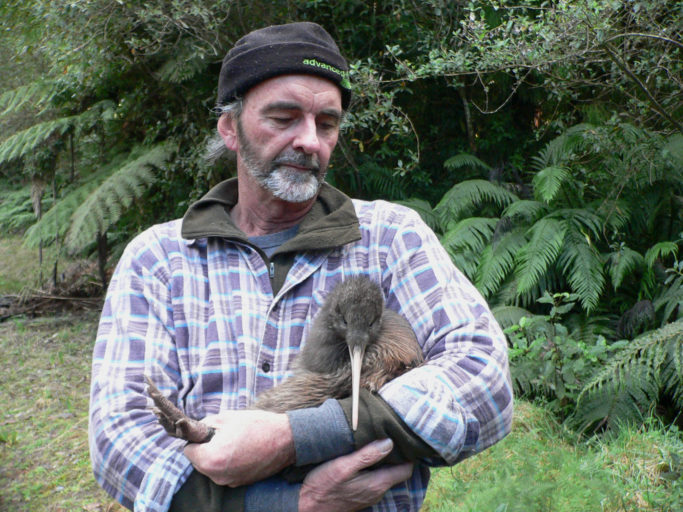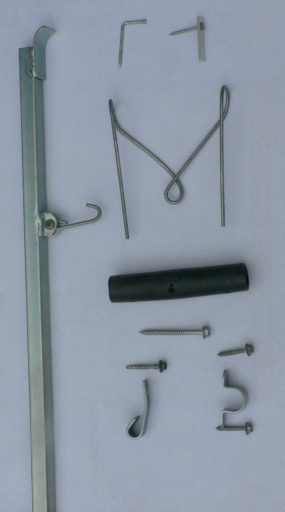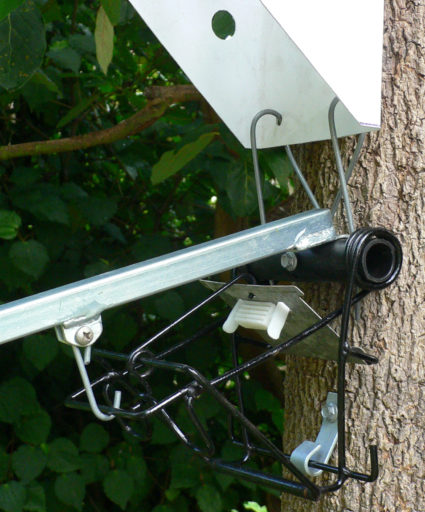Traps need a powerful spring mechanism to kill humanely and that can make them difficult and a bit daunting to set, especially traps designed for larger pests and predators like possums and ferrets.

Dave Edwards is a retired engineer, long-time community trapper (for Bay of Plenty kiwi and kōkako groups) and an innovative investigator. After learning that some volunteers were unable or unwilling to set Sentinel possum traps, he took up the challenge to make the Sentinels more user friendly. It’s a continuation of work he’s been doing for a while on improving the tools available for ship rat and possum control, for little cost. [You can read about his earlier work on bait station baffles here.]
“Lockdown gave me a chance to write a paper on making the Sentinel possum traps user friendly,” Dave says. “The community groups and their volunteers using this system think it is great. One large group have now decided to stop using toxins for possums unless really required and use traps.”
Recently Dave held a training morning for 30 people and, with trapping volunteers in his own community responding positively to the new trap setting method, he’s keen to share his ideas more widely with other community groups and trappers.
“Using single set kill traps for possum control is often overlooked in favour of toxins but they can play an important role. One problem with volunteer community groups using possum kill traps is that by their very nature the traps pack a fair whack and if something goes wrong it can be serious.”
Dave emphasises that he has no association with the manufacturers or retailers of Sentinel traps.
“My involvement is due to an approach from a community group who wanted to use single set kill traps for possum control over 1,200 hectares but couldn’t find a trap they were happy with for volunteer use. They had dismissed the Sentinel because they can be a pain to set,” he says.
So how can you make your Sentinels easier to use? Firstly Dave describes the standard Sentinel operation.
“The standard procedure for the Sentinel trap is to mount it on a suitable tree approximately 1.2 metres off the ground. A length of alkathene pipe is fixed to the tree using a nail through the centre of the pipe and the trap slides over each end of the pipe. To set the trap or remove a possum requires removing the trap from the alkathene pipe and holding the trap on the ground by the outside lugs with both feet, lift up the kill bar, remove the possum and reset the trigger, you are then ready to refit the trap to the alkathene pipe and re-lure it.”
The Department of Conservation has produced a video demonstrating the process for installing and setting the standard (unmodified) Sentinel trap:
“The corflute covers can be a problem blowing away in the wind which can create a safety issue, plus it allows any animal approaching the trap from the top or side to set the trap off without getting caught, or worse caught by just a leg. People have come up with using a piece of nylon cord to stop the cover blowing away. I suggest using a 5mm nylon cable tie across the lower section of the slot in the cover.”
The modifications Dave made are to the method of mounting the trap on a tree and a setting tool to make the process of setting the trap and possum removal more user friendly.
“The first change was to drill out the nail hole in the alkathene pipe to 7mm and use a 6x75mm TEK® screw to mount it to the tree. The other addition was to make some clips from 3×20 flat bar to retain the bottom of the trap to the tree using a 35mm TEK® screw. My pest control colleague Mike Goodwin came up with the idea of using a 25mm zinc plated saddle clamp in place of my clip, which could be easier as not many people have a metal bender.”
Some of the other changes Dave and Mike carried out are not strictly necessary but also beneficial.

The pile of secondhand Sentinels that I was given had most of the Core flute covers either missing or falling to bits. Price for covers is $4.50 + gst + delivery, so I decided to build some better covers out of UV stable plastic. This also allowed me to increase the diameter of the holes in the sides of the cover, (100% open area increase over standard).”
Pen trial research showed that the more open the sides the better as possums appeared to be less wary.
“Because the paint coating on the traps was peeling off and rust forming, we decided to water blast off the paint and have them zinc plated.”
Dave advises you should never galvanise a trap as it can damage the springs.
“I find that zinc plating gives about ten years protection by which time you should be retiring your traps anyway, as after ten years in the set position the springs would have lost too much tension to give a reliable humane kill.”
Number 8 wire also featured in the modifications.
“We also folded some No. 8 wire forms, the legs of which slide into two 5mm holes drilled in the alkathene pipe just inside the springs. The purpose of the wire is firstly to stop the trap falling off the side of the alkathene pipe and secondly to retain the cover, it also allows the cover to be folded up out of the way while setting the trap. This method can also be used with the standard corflute covers but you need to cut off the section that sits behind the alkathene pipe. To secure the cover up out of the way we use either a bent over 75mm nail which after a while can be hard to turn, or an aluminium tab fixed with a 40mm nail.”
- Use either a bent nail or Aluminium tab to retain the cover out of the way
- Wire form does two jobs, it stops the trap from falling off the alkathene pipe and retains the cover, it also allows the cover to be rotated up out of the way while setting the trap.
- 6x75mm TEK® screw replaces the nailTo retain the bottom of the trap to the tree use either Dave’s retaining clip or a galvanised saddle clamp.
- The setting tool is on the far left.
Mounting the Sentinel on a tree is much the same as normal, Dave says.
“Slide the trap over the alkathene pipe, fit the cover to the wire and slide the wire legs through the pipe until the loop in the wire lines up with the screw hole in the pipe. Slide the TEK® screw through the pipe and loop in the wire, then give the leg section of wire that sits past the pipe a small bend inwards to hold everything together and also makes sure the wire legs don’t catch on the trap.”
You then screw the trap assembly to the tree.
“There is no need to really tightly wind in the screw, as long as the wire and pipe butt up against the tree that’s fine,” says Dave. “An advantage of using the screw is that you can unwind it as the tree grows. Using either the metal clip or saddle clamp fix the bottom of the trap to the tree. Don’t tighten the trap hard against the tree, having about 15mm movement in the bottom of trap is good.”
“It’s very important that the lower section of the galvanised plate that the bait block is mounted in does not bind on the tree or this could affect trigger sensitivity,” Dave advises. “Generally this is not a problem and can be sorted before screwing the trap to the tree by simply holding the trap in position on the tree and checking how it sits.”
Finally set the trap:
“To set the trap first lure the bait block then simply place the hook on the setting tool under the traps lifting handle and the slightly rounded end on top of the alkathene pipe, position slightly off centre to the right as this makes setting the trigger with your left hand easier. Lift up the handle until the kill bar is high enough to position the trigger wire in the normal manner, drop down the cover and locate it under the tabs on trap.”
Check out Dave’s demonstration of the modifications and how to set your trap:
Positioning of the traps is important and Dave has some tips for those new to trapping
“As well as landscape features look at the trees. Possums like to investigate before they stick their head in a strange place. Running boards give higher catch rates than a straight tree or you can look for features where a possum can sit check out the trap and salivate over that lovely lure, places like a fork in the tree. Place the trap up from the fork where a possum can comfortably reach it, or look for a suitable tree limb slopping up from the main trunk. However, if you have ground birds like kiwi or weka you must always ask yourself, ‘Is this trap location safe for those birds?’”
Dave reckons these changes can be made for a few dollars per trap, a bit more if you want to use a better trap cover.
“Single set possum traps can play an important role in protecting our native biodiversity, but they are often overlooked as being too hard. Often groups are controlling a range of pest animals so you can combine trapping operations by having say stoat traps and possum traps set close to each other and checked at the same time. We are finding that this approach is not taking that much longer and the ‘Stoatees’ are enjoying the extra role of possum trappers.”
Dave says there are other advantages in using traps for possums too.
“I tell groups that well set possum traps can actively reduce possum populations throughout the whole year, compared to a one hit toxin operation where every possum you kill for the whole year will be in a one or two week window. Possums who survive the toxin operation because, say for example they were already keyed into a seasonal food source can then do what they want for the rest of the year, as can possums who wander into your block after your toxin operation.”
The good news is Dave reckons possums can be relatively straightforward to control.
“There has been extensive research carried out on possums covering, behaviour, breeding, dispersal etc. In our favour are, they are not very smart, breeding rates are fairly low with yearly population increases of around 25%, dispersal from non-control areas is fairly random, so they don’t automatically on mass re-invade an area where possums have been removed.”
“It is also worth doing some homework and look at roughly how many possums you have in your block. The relationship between RTC and possum numbers is claimed to be fairly accurate between 3 to10 % RTC, with 5% being equal to one possum per hectare. Take into account that if you pick away reducing possum numbers all year then how many are actually left to breed, and how quickly you might get down to your desired level. It might not all be as hard as you first thought.”

So far Dave has made about 50 setting tools for groups at cost, including one down in Wanaka for three groups to evaluate. He has also trained up a retired couple to make some of the bits and piece for the group they work with.
He’s already getting positive feedback from happy volunteers.
“One email I got was from a lady I don’t know who wanted to say thanks. She is with a Rotorua group and said that she could not set a Sentinel before, but with the setting tool etc, she has now taken on a possum line.”
Another volunteer trapper had this to say:
“We have only really had the experience of a Conibear trap and Doc 200 prior to being exposed to the tree-mounted Sentinel. The setting and clearing process is a breeze and after one day’s use we had the confidence to both carry out the task. We were in fact teaching others almost immediately. We felt safe and confident after a few attempts. It is great to see the possum population being impacted and certainly value the additional safety this provides to our breeding birds such as kiwi and kōkako along with all the others in the forest.”
And from the Otanewainuku Kiwi Trust:
The Otanewainuku Kiwi Trust looked at the 3 NAWAC approved possum traps and the Sentinel was our preferred option, but we had reservations from a H&S aspect as we are a volunteer organisation and the traps are not the easiest to set. Dave’s setting tool and the brackets for securing the trap to the tree have made a good possum trap even better by being easy to set and user friendly at very little extra cost.
“I certainly don’t claim to have all the answers, but if you currently use the Sentinels why not give the modifications a go on some of your traps for a trial. I think your volunteers will love you for it!” Dave says.
Anyone interested in finding out more about the Sentinel modifications can contact Dave directly at:
Dave Edwards: Email [email protected]; Phone 07 544 0885.
Check out Dave’s earlier work with bait station baffles.

